Bread has been a staple of almost every human civilization. The grinding of seeds or nuts into a flour and the kneading of that flour, sometimes leavening, dates back thousands of years.
Across ancient Europe, into Africa, parts of Asia, South, and North America all had some version of ground flour that was turned into a fluffy bread or an unleavened bread.
From the temperate areas to the extreme heat of the desert and the ruthless cold in northernmost regions. You find flatbread in the Middle East and India and bannock from the Natives in places like Canada.
To be an effective baker of bread, you need some skills and ingredients:
- Flour
- Yeast (if you choose to make a risen bread)
- A Sturdy Mixing Bowl
- Strong Arms for Kneading
- Patience
- A Stone in your Oven
The Grinding Process
Grinding seeds and dried roots into flour requires some tact. You cannot just toss them into a food processor and buzz. Some nuts and seeds are too strong for a food processor. Others can be whizzed up into nut butter if you are not careful.
You can invest in a hand grain mill. Of course, preppers see the value in that because there could come a time or a period where electricity is no longer available.
Your high powered grinder will be no good without electricity. However, the hand grain mill is no picnic!
Another tip is to assure that the items to be ground are roasted or thoroughly dried. You will never make flour if there is too much moisture. You will only make a paste.
Now let’s look at the 6 backyard plants that you could use, right now, to make flour with and then use that flour to make bread.
Acorns
Native Americans have used the big oak’s acorns to make flour for a very long time. They would even eat them just as they fall. There is a good chance you have acorns in or around your yard right now! They are common.
However, they are also filled with tannins and because of that, they are so bitter that you need to leech out the tannins. This can be done by boiling them in several different pots of water. Start them in cold water and then bring that water to a boil.
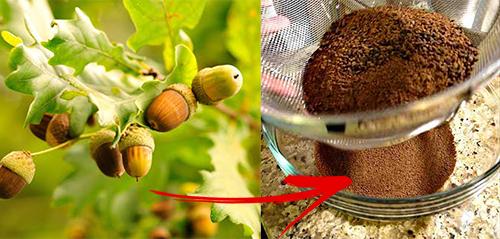
Dump the water and start the process over. Do it at least 3 times to get to an edible state. Food that is heavy with tannins will make you vomit if you eat too much.
The acorns should be shelled, roasted and pulverized before the leaching process. Also, go for the white oak when it comes to harvesting. They have the least amount of tannins.
Related: How to Make Acorn Flour
Amaranth
Amaranth seeds are becoming increasingly popular. They are a much healthier alternative to regular flour and even has a decent protein content.
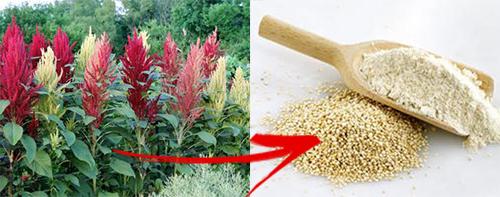
You will have to either grow amaranth or know of nearby amaranth field.
Amaranth is easy to harvest when you find plenty of it that is bearing seed. Amaranth is also a gluten-free option for those who need that.
Related: Amaranth Superfood- Storing And Using It For Survival
Dandelion
Dandelions are unique because you can actually make bread using the flowers from the dandelion! You don’t even need to turn it into flour. You could use your acorn flour and some fresh dandelions to make a completely foraged loaf of bread with multiple ingredients.
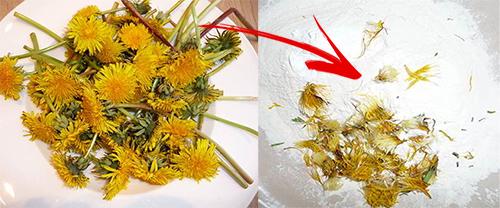
Please see here how to make dandelion bread step by step with pictures. This is a quick bread that requires eggs and is very tasty.
Related: How To Make Survival Dandelion Jelly with 2 Years Shelf Life
Cattails
The cattail has long been known as the survivor’s best friend. From their edible shoots to their tinder tops and even that starchy root. We are going to focus on the root in this one. If you source a few nice sized cattail roots you can make some cattail flours.
They will first have to be washed off and then sliced thin. Place these into a 200-degree oven for 3-5 hours to dry them out. Some people will roast them, but I like to nearly dehydrate them.
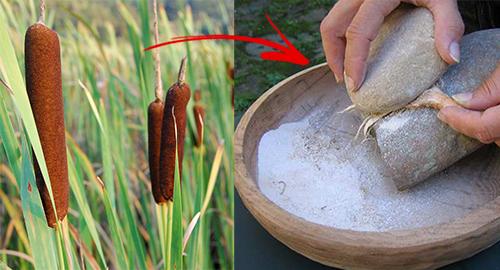
Remember what I said about moisture. Plus, you can avoid adding oil or anything like that.
Once they are dried you can run them through your grain mill. This flour can be used to make bread that is either leavened or unleavened.
Related: Delicious Recipes Using Cattails; The Supermarket of the Swamp
Curly Dock
Harvesting curly dock seeds will require that you have a serrated blade because the stem is woody. You need to be wary of things like rot and bugs. Bugs like to hand under these seed pods. You don’t want blended bugs in your flour.
I will warn you; it is no quick process here but it’s worth giving a try.
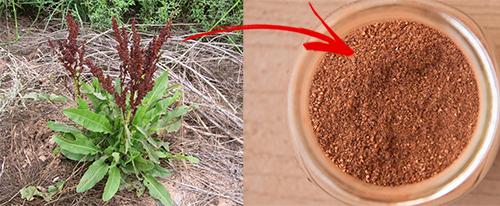
Shuck the seeds off the branches and onto your sheet pan. You will want to pick through them and then rinse them all before drying in an oven at 200 degrees for about 15 minutes.
You are then going to want to roast them for about 15 more minutes. This will help separate from the chaff which can be tedious.
After the chaff is separated it can easily be ground into flour and that flour used as a substitute or combined with wheat flour.
Related: 21 Wild Edibles You Can Find in Urban Areas
Crab Grass
You might not believe it, but crabgrass was a popular edible used to make flour, a couscous like food and even fermented to make beer! One plant puts out up to 150,000 seeds.
Like most plants with small seeds, it is a time-consuming process to husk them all. Ancient peoples used a mortar and sand then a fine sieve to get the work done. No matter how you do it you can get a massive amount of seeds.
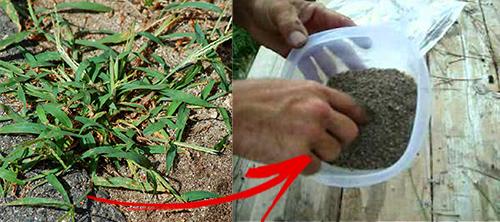
In fact, crabgrass is a popular grain in Africa and yields 17 tons per acre! This might be the perfect backyard ingredient for making bread.
Many of the practices, skills, and foods that kept our ancestors alive have been thrown out and forgotten. It is one of the darkest parts of the 20th century. The convenience that made life feel so good erased the need for self-reliance and independence.
Every one of these backyard flours and corresponding bread is something that people eat in other parts of the world or have eaten throughout history.
If you plan to depend on flours and bread from the backyard, now is the time to be making them. Trust me. Don’t make the mistake of learning how to separate the chaff from curly dock seeds when you have a hungry family at the table.
You may also like:
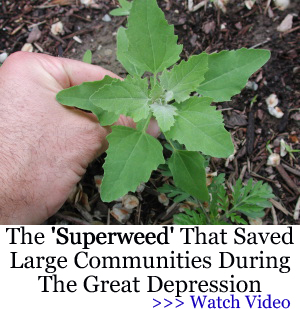 Similar to Morphine: The Best Natural Painkiller that Grows in Your Backyard
Similar to Morphine: The Best Natural Painkiller that Grows in Your Backyard
Learn How To Can Hamburger Meat For Long Term Preservation (Video)
16 Wild Edibles You Didn’t Know You Could Forage For

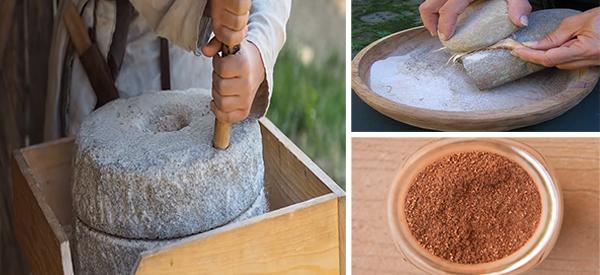













In the PDRK, buckwheat grows wild. You can make flour from buckwheat. The Japanese made noodles from it and I understand it is a staple in the Russian army. However, unless your backyard is pretty large, you probably can’t grown enough buckwheat there to make a bowl of noodles, let alone back loaves of bread. Because it grows wild, usually when I have seen it, it takes over a whole field, so if you find a field of buckwheat you can probably harvest enough to make a fair amount of noodles and other items with. The Japanese don’t use yeast in their noodles.
I’m not a botanist by any means but I would imagine buckwheat would grow anyplace wheat would grow.
Hi, Chuck. Buckwheat is pretty amazing. In spite of its name not related to wheat but more to rhubarb. Likes cooler weather. Doesn’t do well in hot weather. Will flower in about 3 months or so. Ideal for northern climates. Does well at high latitudes and northern climates. You can probably grow buckwheat anywhere barley and potatoes do well. Potatoes originally come from Peru.
Armin: See my last sentence. Two years ago I took a six week course in medicinal plants of the Southern California Coastal (I want to say plains, but that was not the title).
Anyway it concerned medicinal and edible plants that grow in the intermediate coastal regions of SoCal. Six weeks course — that makes me an expert ehhh?
I had always thought elderberries were poisonous. Uh Oh, looks like my PhD in botany is drifting away. I had always wondered what the fairly vast fields of red weeds were. Turns out that is buckwheat. Masters, maybe? In the low valley areas of California, Mono and Inyo Counties there are really vast fields of buckwheat. I had heard of buckwheat, of course, because the Japanese make soba out of buckwheat. Never knew it grew in the PDRK.
They grow commercial quantities of potatoes in the area around Bakersfield because I once had a woman work for me who had worked picking potatoes in the Bakersfield area. She said it was the hardest work she had ever done in her life and that her hands were never completely clean but always had dirt ground into them. The reason I mention that is because you indicate that buckwheat will grow where potatoes grow but Bakersfield is hot, hot, hot. My brother lives in Bakersfield and it is not unusual for the temperature to go over 100°F for days on end in the summertime.
With all that preamble, it must may be that although buckwheat can go wild in apparent abundance (heavy emphasis on abundance) it may not be growing in sufficient quantities for today’s commercial market. Of course, until two years ago I didn’t even know that it was buckwheat and since then I have not gone out into a field of buckwheat to see just how well it was growing. Land is too expensive in California and water and electricity are also too expensive to grow any crops that do not sell for a good price.
That is why strawberries and blueberries are the crops now grown in this county rather than lima beans and sugar beets which were the original field crops grown in this county when the settlers from the east moved to California.
I think if buckwheat prefers cooler climates, those valleys you said they are growing in, in SoCal must be in shadow enough to drop the temp enough to allow for the growth…hmmm? Just my guess if they do need cooler temps!
It could also be that the buckwheat you are seeing has been cross bred/hybridized to make it more hardy in the warmer temps of SoCal! I also wonder if the time of year it is flowering is in early spring when it is still cool or even maybe late fall, and because it is new to you, you didn’t take note of the time of year if it truly needs the cooler temps.
In comparison we have many apple species who can be grown in warmer climates, but still need a certain amount of cool temps in order to be able to produce fruit, but they crossed various types so the new breed didn’t need such cold temps and/or maybe not as long in the cold temps to be able to produce fruit.
That is why I am thinking the plants you have may be hybrids to be able to withstand the temps and still be able to produce seed in warmer climates! Just some ideas bouncing round in my head! Much love to all!!!
Suzzane: It’s a native buckwheat. By and large, anything native to the northern Pacific rim is on goth sides of the ocean.Ours is a perennial. Eurasian buckwheat is an annual. niio
http://www.irconservancy.org/landmarks-blog/wildlife-spotlight-california-buckwheat
Hi Suzanne: The buckwheat I am speaking of is growing wild and has been growing in uncultivated fields since I have been going to the Mammoth ski area. If I recall the naturalist’s comments about buckwheat, it is not native but has been growing here in this region for so many centuries that it is now considered native. Even so, it still may not grow in quantities to be considered for commercial use. Some time ago I read figures for production of wheat and other crops during medieval times as compared to present day productions figures and while I didn’t bother to commit them to memory so that I can recite them, I was impressed with the huge difference in production figures per hectare of land. It is easy to see why even the best of fields only produced a meagre hand to mouth existence for all but the wealthiest — who managed to grab the biggest and best portion of any harvest for themselves.
Chuck: Mind red elderberries. People ate them, but never the seeds, which are toxic. niio
Red: The naturalist presenting the lecture series mentioned that the elderberry seeds contain cyanide which of course is quite poisonous but, he said, the amount in each seed is minuscule and that one needs to consume a large quantity of seeds in order to feel the effects of the poison. To demonstrate he ate some and appeared to swallow the seeds. I know for a fact that two years later he is still alive because he is still presenting courses on the uses of various native and introduced flora.
The whole purpose of mentioning buckwheat is to point out that it grows abundantly in some areas of SoCal and while it may not grow at densities that make it a viable cash crop, it certainly could provide sustenance for emergency living should the need arise. It wasn’t mentioned in the article as an alternative to wheat flour, But I know that the Japanese eat tons of buckwheat soba (noodles) every year and I have read that it is a mainstay diet item in the Russian army, where, from the article that I read it is consumed much as we eat oatmeal in this country.
According to archaeologists and anthropologists, Indians did not eat seeds of the red elderberries. Not even without seeds for breakfast. It caused stomach aches. Blues, yes. those are fine. When eating the reds, they always removed the seeds. there’s no sign on any dig showing the reds had been cooked with the seeds in them.
I’m not disagreeing, per say, I understand, but wanted to point our native buckwheat grows best in deylands and is usually considered a perennial, making it superior in that way over foreign buckwheat.
https://calscape.org/Eriogonum-fasciculatum-(California-Buckwheat) is also native to parts of Arizona. Eurasians have two types, https://en.wikipedia.org/wiki/Buckwheat esculentum and tataricum. Yes, there are foreign buckwheat growing all over the country into Canada, but these aren’t native fasciculatum but Fagopyrum esculentum, a different species.
We had a lot of buckwheat in Areas of Napa county when I grew up there. In coastal Mendocino county we saw some but where I lived for a while on Round Valley Reservation I never saw it.
Cattle, sheep, goats, and horses like it. Some varieties can grow at 7,000 feet. European needs 100 days frost free cooler than we get here. In the last few years, land jumped from several hundred/acre to over 4,000. A shame no one domesticated American buckwheat. It likes the heat and withstands drought. niio
Love buckwheat pancakes.
ClergyLady: I’m going to get some buckwheat seed and see if it’ll grow here during the monsoons. That or I’ll be heading to Penna to buy a few hundred lbs 🙂 But, I want to try Chuck’s, too. BTW, had the dog to the vet’s. 200 bucks. and they want him back next week. Wow, but when things bite, they BITES 🙂 niio
Yup.I get it. Truck has a broken spark plug that messed up the threads. Looking at nearly $350 between new plugs and messed up wires, lining and rethreading the seat for the spark plug. But hope to be back on the road some time tomorrow. Wish this right hand were up to still doing that kind of stuff. Havent Paid a mechanic for much in my lifetime. I’ve been knitting and crocheting working on getting better control but I wonder if I can ever rebuild enough strength. Hate the bar in the arm. Lift anything more than 8-10 lb or using a hammer reminds me the bar is there.
ClergyLady…If I may, you do know using a sledgehammer as your main tool might damage the truck? Just a thought. Praying for you! niio
Damage the truck. Lol. A sledge sure would be inviting. If only I could survive the tickle when landing it.
The California buckwheat being mentioned in earlier comments is extremely draught resistant and needs very very little water. I feel like I have seen more of that than any other plant in Southern California, specifically the la and Orange County areas. It grows in abundance even in the Mojave desert.
Daniel: Small seeds, but good eating. Great in a hidden garden because most people think it’s a weed/wildflower 🙂 I’m trying to get it started here, in my part of Arizona, but the drought and air pollution from the wild fires aren’t helping. But, this year I planted 2 packs of them with other things. niio
Good article, thank you 🙂
Thank you for sharing this information. Long time ago my wife studied herbal medicine, and we occasionally gathered wild St. John’s Wort to steep in a large jar w Olive Oil. You need to be confident you’re not gathering near any fields where Pesticides or Herbicides were used, or along heavily-used roadways, because of fuel additives. I love the idea of crabgrass, but homeowners and golf courses and sports field typically use FAR more fertilizers and chemicals than agricultural fields. Exercise Caution.
You do not necessarily need to boil acorns to remove the tannins, if you have running water nearby. Put whole acorns in a cloth sack, tie it up, anchor the sack to the bottom of the stream/creek, well-under the running water. Leave it for a couple days; then dry the acorns in the sun, and shell. The running water removes the tannins.
A candy company in German does it like the ancestors. They bury acorns in moist soil and let them go till late winter. then, when the acorns start to sprout, process them. It’s like grain sprouts, tannin is gone, and starches convert to sugars. They do this in the mountains, the Black Forest. If acorns start to sprout too soon, thanks to a warm fall and winter, there’s still tannin in the nuts. A niece over there said bury them deep. Down here, south AZ, we have englman’s and blue oaks. No tannin in the acorns. Just roast them and they taste like hazelnuts–but get permission from ranchers, who pick them to sell! niio.
Can you make Quinoa into flour thus making bread etc. as it grows so tall and gives so many seeds.
What kind of quinoa? White or red? I was told both need to be washed to get rid of saponine. Red is very strong in it and that makes it about bird- and bug-proof. I was going to try beet seeds (a relative) but the javelina got the beets saved for seed 🙂 niio
Yes! Sorry, but I was in too much a hurry when replying. It’;s supposed to be the same quality as buckwheat. Mixed with 1/3 starch, it’s used for noodles.
Yes JC you can make flour with quinoa.
I add ground amaranth to flour for muffins.
Great idea…and a good way to practice learning these skills. I think I will take some of my dandelions…dry them out, and mix them in with my cornmeal next time I bake cornbread to practice learning. Maybe I will also do it with some kale leaves or violet leaves and see how that turns out. Good way to extend what flour, cornmeal, etc we have on hand when SHTF. This will be fun!
I just made my first ever batch of orange marmalade two weeks ago and it came out delicious!
I’m ready to start canning now! I am enjoying learning all this great stuff and becoming more self reliant!
A important note on cattails, the pollen can cause uterus contractions, so it must not be used b pregnant
women
All grasses – including Lemon Grass – is EXTREMELY BAD FOR YOU!!! The Human body was not designed to ingest and digest grasses. Unless you are literally starving to death, do not eat any grasses!! There’s plenty of info out there on this, just do a web search.
Bell: that goes for grain, as well. But, as with grain, a little goes a long way. niip
Bell Cay: One of the problems with universal statements is that invariably there are exceptions. I remember a statement from one class or another that the only universal dictum is that there is no universal dictum.
Right off the top of my head a grass that I know of that is eaten extensively is bamboo. Bamboo shoots are a much sought after delicacy in the Far East and almost every culture there eats them with gusto. As a matter of fact, I have eaten them regularly with the same gusto since I first set foot in the Far East in 1956.
When I was a kid, long, long ago and far, far away there was a grass that when one pulled the stalk out of the base, there was a juicey succulent portion that we used to eat regularly. Obviously it wasn’t a significant part of our diet but we would eat our fill of those stems when we were out in the fields playing where it grew abundantly.
I have seen something similar mentioned in various articles I have perused regarding foraging among wild plants and the author usually described eating it in the same fashion that we did as kids, right off the plant.
I don’t remember any of us suffering from any gastric difficulties. I didn’t and none of my compatriots ever said, “Don’t eat that stuff it’ll make you barf !”
Obviously, as old as I am, it hasn’t had any long term effects either, otherwise I would have shuffled off this mortal coil long ago.
Obviously there are some grasses that may have detrimental effects if consumed. One of the problems that I face is that many plants that are edible in one fashion are advisedly not edible in another fashion. Or, one plant is edible but another plant that looks alarmingly similar is quite dangerous to ingest. I am sure among the multitude of grasses that grow over the world, there are grasses that are harmful and grasses that are beneficial.
I suppose one statement that one could make that would be accurate is that generally (underlined) grasses are low in nutrition and therefore harvesting them uses more calories than one gains from eating them resulting in a net loss. The trade-off is that they contain necessary vitamins and minerals that are not available in foods that provide more calories per ounce consumed.
In one of the posts concerning foraging for wild plants the author stated that it was necessary to be completely familiar with the plant being foraged so as not to harvest some different look-alike plant that could prove to be harmful. That little tidbit is perhaps the most important point in any discussion about wild plant foraging.
You guys don’t know anything about oak trees and acorns. Acorns from a white oak tree keeps the acorns for 1 year. There is very little tannic acid, compared with the red oak which keeps acorns for 2 years.
Bluer oaks and Englmann have no tannin. Both are now commercial crops in the Sierras in northern Mexico and the US border states. In Germany, they take black oak acorns, very high in tannin, and bury them till spring. Tannin leaches out, and when the acorns start to sprout, they process them for nut butter and candy, they’re that sweet. But, if any of the sprouts start to green, they get bad, again. niio
I have burr oak which I think is a white oak. All acorns every year have worms. Can we still eat them after we roast them? We are talking post civilization here.
Spike: The “guests” in German and Japanese “guest” camps were delighted to find bugs in their food. It was a small source of protein in an otherwise protein-free diet.
Most worms and grubs are edible. If they have been roasted they will be edible. I won’t comment on how they will taste as that will be an individual thing.
Everything I have read about eating insects indicates that they are a high source of protein for weight of the item consumed. Now munching a half dozen grasshoppers deep fat fried may not approach the gustatory pleasure of an equal handful of Lay’s ocean salt potato chips, but they will provide more protein than the chips.
There area in the world where insects are consumed as a regular part of the diet. My wife assures me that during WWII, grasshoppers deep fried like tempura were a fairly regular part of the diet although not one she was particularly fond of.
There are some insects that are poisonous and I wish I could name and describe them for you, but alas, my degree in entomology is still in the mail. Perhaps some reader on this list who has solid knowledge of which insects in North America are poisonous would be kind enough to enlighten us.
My recollection from what little reading I have done on the topic is that most of the poisonous insects are caterpillars and they have bright colors. That said, that recollection could also be 100% erroneous, so I would urge you not to rely on it without verification from some genuinely knowledgable source.
Native friend here in NM used to recount as a kid they’d catch grasshoppers and put them in a paper bag. They’d lay the bag in the hot coals and let if burn. Then as the coals were cooling they use a stick to pull the roasted grasshoppers out and eat them for a treat. She claimed they were crunchy and a bit like peanuts. Said all the kids enjoyed them as a snack when they were in sheep camp.
ClergyLady: I had a recipe from the Medieval Era for fruited grasshoppers. Others for honied crickets and so on. I learned about the paper bag trick for scorpions. They’re better boiled with garlic butter sauce. niio
Spike: Chuck is right. Ugly but tasty. If you can, can you run a feeder pig in the oaks? they’ll eat every wormy acorn they find. Burr oaks are white oaks. Drop the worms in boiling water to clean them, as you would earth worms, then toast them. In another post, I said a wise old farmer, who had a degree in agronomy, said nothing much survives a cow’s guts. they’ll eat the acorns, as well as turkeys and so on. In fact, any bird or hog will take the bad ones, first. If you don’t have animals but would like to eat the acorns, then rake up all the acorns as they drop and burn them. Goes for fruit, as well. It won’t eliminate them, but will cut deeply into the population. I just picked a mess of blue oak acorns yesterday that were good yet. Eat well niio
My acorn worms are very small. Maybe 3/16″ long and diameter of a hair. I’m guessing they are coming off the tree infested already. Haven’t studied them to see if they grow up into something bigger. I just knew I didn’t want to eat them at that time of my life. Who knows about tomorrow though.
When I checked the acorns, they go in water. Floaters are discarded. Ours are from a half inch to 3/4 long, half an inch wide at the most. The more cap, the more tannin.I never heard of such small acorns. niio
We had a neighbor who was always trying a new bug, larva, or ant to eat. I think mostly it was an excuse to eat chocolate. I can do that without ants in it.
But during that 10 months stretch I drank pollywogs and minnows. If there were a wormy looking creature in the seeds or nuts it was consumed lightly toasted along with whatever it was on.
Hunger does change the appetite.
Speaking of food. I stopped at Wal-Mart to get milk and bread. Walk down the aisle where beans and rice are…empty. Gal came to restock it and mentioned they fill it and its empty again before they can load the cart and get back again. She did point out that in the bulk items they are now carrying a full 3 lb can of regular ground coffee. It was under $8 so I took three. I’ll try one. If its good we’ll use it up. If not I’ll save the other two if I need something to barter sometime.
coffee, tobacco, and so on are luxury items, and should be treated as valuable. Coffee beans last longer on the shelf than ground. Tea is a very good item as most is grown overseas or Mexico highlands. I stropped at Wally-World (WalMart 🙂 yesterday and got half of what I would normally. Most of what we use is still normal priced. Note, bought hamburger and there’s more fat ion it now. but, that hath its uses. niio
A couple points about flour and leavening.
You don’t actually need to have dry flour to make many kinds of bread. This makes sense if you think about it – why dry things out only to add liquid back in to make the dough?
And bread made with the paste (or what’s usually called mash) is often much healthier than that made with flour, because you get the nutrition in the liquids of the seeds/grains as well.
But there are two advantages of dried flour.
First, it’s much easier to store. Dry foods last much longer than moist ones.
Second, it has consistent moisture levels, so it’s easier to follow a recipe. If you use mash, you may need to experiment a little to figure out how much water or other liquids to use, and there may occasionally be differences in the moisture level that you need to adjust for. But in addition to likely being healthier, if you’re not planning to store the flour, then mash can also save you the step of having to dry out the grains or seeds, so it’s worth considering.
Regarding leavening…
Baker’s yeast has only been used to leaven bread for a relatively short time in human history. Many sourdough cultures can be used to leaven bread instead of baker’s yeast (often called natural leavening). It takes longer than baker’s yeast, and often makes for a denser loaf, but many people also believe naturally leavened bread (using various sourdough starters) is both tastier and healthier than yeast-leavened bread.
The main advantage of naturally leavened bread, though, may be that you can keep and manage your own starter culture even when baker’s yeast is not available. Even if you do use baker’s yeast, you may need to create your own starter from it before you run out of the packaged variety (or before the packages lose their potency)… so the art of making and keeping a starter is a skill that may be useful even to those who want to make their bread with baker’s yeast.
When they wed, one gift given both my grandmothers was a pack of store-bought yeast. They were expected to never buy another. We like flat bread, like tortillas, but there’s always a bowl of sourdough rising. Once sourdough hits a certain acidity, molds cannot grow in it, so it can be stored on the shelf just like the wet kind. Sourdough liquid is a grain vinegar, and when done fermenting will keep on the shelf longer than regular vinegar. It’s just as good and higher in vitamins. Partially cooked whole grain with starter over it is the fastest and most consistent way. Not flour! We drain the vinegar off, and wet grind (in a food processor) the grain for dough. niio
Hi,
Please tell me more about using partially cooked whole grain with starter over it. Do you use partially cooked whole grain wheat or another grain? Will you please give me a recipe for making your sourdough and how to get the grain vinegar. Do you use it just like apple cider vinegar? I live in northeast Arizona and we have lots of oak trees, but I am not sure what kind of oak they are. Will you also send me instructions on removing tannins, roasting, recipes for using the acorns, and if I would grind into flour with a bosch wheat grinder? I have tried to make apple cider vinegar and my own wild yeast and I have not been successful. Do you have any tips? I appreciate your comments! You have some great info! Thank you so much!
Poppy: Good afternoon, neighbor! I’m in San Pedro Valley, northeast of Tucson. Grain vinegar costs ten times more than fruit vinegar. You can use wheat. That’s popular in Europe, but we’re gluten intolerant. Rice and some other grains are good. Sorghum and Sudan grass produce some cyanide if sprouted, but are probably all right if cooked. One more thing, if you want the vinegar to be clear, use beer yeast or wine yeast.
The grain should be washed 2-3 times, no hulls. Soak overnight in clean water. Partially cook, cool, put in a good food-grade bucket (a lot of donut shops toss them, but stores and so on get salads in by the bucket). Cover well, let it ferment. You can add yeast if you want it faster. After 6-8 weeks drain off the vinegar and bottle. We use juice bottles and store them in the pantry. Koreans will start using it then, but let it continue to ferment for up to 6 months, adding to it.
I don’t know about Bosch, but if it allowed wet grinding, then it should have some sort of seal to stop from making a mess. And, if stone, it might plug up the stone.
Use yeast as a sourdough starter. It has to be used several times a week with more flour added. A little milk helps it sour faster. When my grandmothers married, their mothers gave them one cake of yeast that was to last a lifetime.
Vinegar is fruit juice plus yeast exposed to air. Lees, the dead yeast, is 36& protein. but, some wild yeasts are toxic. Use regular.
In Germany, a nutbutter made of black oak acorns is popular. Rather than wash the acorns or flour, they squirrel them away.. Yep, bury them. By spring, when the acorns start to sprout, no more tannin. But, they need to be shelled bast and cooked because even a little green means tannin. I was told it’s good, naturally sweet, and keeps well.
We have blue oaks here. But, you pick in the wrong patch, people will run you off. Cut the trees, they’ll have you arrested for stealing. Blues and Englmann’s can be eaten raw. Any other oak needs to be processed. niio
Husbands favorite bread or muffins are sourdough. I keep a container fed and cared for. I mix it with enough flour to make pancakes or baked breads.
Alas (as they say in English, somewhere) no carbs. I get sick on them. Strange, but true. If I eat any, it’s feasting on antacid tabs all night. The orange ones are the tastiest.
Blue oaks and Engels are tannin free. More body and less cap is a sign of low tannin in white oak acorns. Black oak acorns are still buried till spring by family in Penna, Germany, and Austria. Once they start to sprout, they get sweet and are used for nut butter. Do not allow sprouts to see light for long or they’ll develop tannin.
Amaranth is tastier popped than popcorn. An annual, it still self-sows by the hundreds, and more with a little help from garden raiding birds. We have Tarahumara and Red Merlot, as well as a native, prickly amaranth. This spring, a commercial open-pollinated variety will be added.
Stuff like buckwheat (Euro and Asian varieties) are planted in tubs as flowers. Very pretty, but hard to grow enough for a pancake. Wild buckwheat (desert native) is extinct in the canyon thanks to harvester ants. But, we’re trying to get it back by feeding ants meal and borax. Collapsing colonies are excellent places to plant other expats like saltbrush, tepary beans, prairie clover, and teosinte. A mining company owns miles of land around town and didn’t lease to ranchers, so most small seeded plants died out. Best place for tiny seeds to sprout and grow is hoof prints. Even saguaro are getting old because of a lack of animals. niio